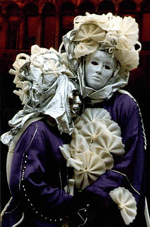

Farewell to Meat, Hello to Fantasy
(A very brief introduction to Carnevale traditions and historyfor attendees of the GBACG Italian Carnivale Banquet)
Carnevale (or Carnivale, or Carnavale, alternate spellings you may find), is a festival which can trace its roots back to the Roman Saturnalia, a festival held in mid-December to honor the god Saturn with feasting, gift giving and role reversal. As often happened with such festivals, Catholics found a way to work the festival into their own liturgical year.
One commonly accepted derivation of the word "carnival" is the Latin "carne vale" or "farewell to meat." Carnival was the final hurrah as winter headed towards spring, and the long Lenten season of fasting and abstinence. It was, perhaps, not only a last chance to indulge the passions of the flesh, but an opportunity to consume any meat which had been put up for winter that might not stay fresh enough for consumption until spring brought the end of Lent and Easter.
Because of its ties to the liturgical calendar, Carnivale varies in
length. It can be considered to begin with the feast of Epiphany (the
12th day of Christmas) on January 6, and always ends on Shrove Tuesday,
the day before Ash Wednesday, the first day of Lent. The Lenten season
is the 40 days before Easter, which falls on the first Sunday after the
first full moon after the vernal equinox.
Confused yet? Don't worry about it. In 2003 Lent starts on Wednesday, March 5, which means the
last day of Carnivale is Shrove Tuesday, March 4. (If you've never heard of Shrove Tuesday, perhaps you've heard of "Fat
Tuesday" -- also known in French as Mardi Gras, or in Italian as Martedi
Grasso. Is it all becoming clear now?)
Carnivale is celebrated with enthusiasm around the world; in the US the celebration in New Orleans is best known. In Brazil, Carnivale in Rio is famous (or infamous) for its wild abandon. Many cities in Italy have maintained or revived their traditions of Carnivale; especially well-known among them are Venice and Florence.
While Carnivale has a rich history and ancient roots in Italy, the festival remains a vital and contemporary celebration. A simple web search will reveal many images of celebrants in both historical and contemporary costumes. One of the common elements found throughout the tradition has remained the Carnivale mask.
Masks were also worn by the lower classes to allow them to mix unfettered with the aristocrats in such situations. The mask, after all, was a great equalizer in a social setting. This was especially common in Carnivale, with its traditions of role reversal and celebration of the fool.
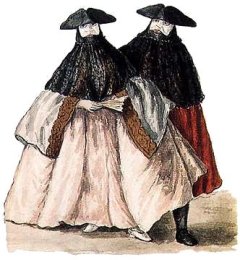
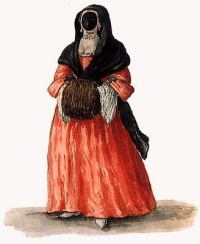
Cross-dress costumes are still very popular in the contemporary Carnivale celebrations.
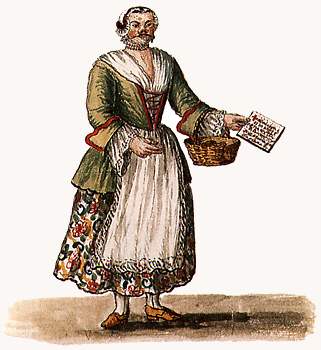
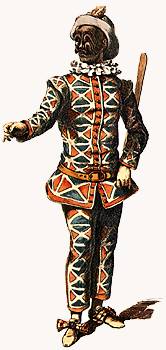
Arlecchino (Harlequin)

Pantalone
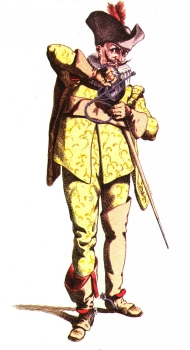
Capitano
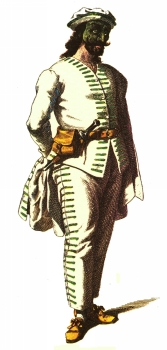
Brighella
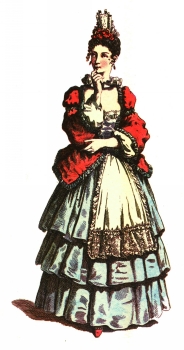
Colombina

El Medico dea Peaste
His costume originally served several functions -- first, in the time of plague, it was a disguise to hide the identity of a physician who by visiting plague victims might be exposed to contagion. The tunic was of pure linen or waxed cloth to protect him, and finally, he always had his trusty staff with which he removed the clothes of plague-victims, thinking that in this way the terrible epidemic would not bring him any harm.
And of course, contemporary Carnivale-goers may occasionally break with tradition and do something more topical than time-tested.

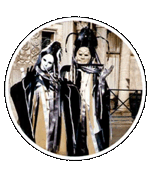
-
The Portale de Venezia "Carnivale in Venice" Site
includes sections about both historical Carnivale and the contemporary celebration. (The illustrations on this page are from this site) -
Carnevale, carnevale,CARNEVALE...
(another Italian site, be sure to use the right hand set of links to get the English pages) -
Frannie Germeshausen's Venice Photo Album
Frannie, the GBACG Events Coordinator, has posted a wonderful collection of photos from her trips to Venice and Carnivale. You'll find many costume photos in particular on page 2 and pages 6-12. -
Carnival of Venice site at delpiano.com
Another site featuring history, costumes and images from both period and contemporary Venetian Carnivale. (If you click on "Carnival Home" from this page, it takes you up to a portal with links to sites about Venice, Rio and San Francisco Carnivale celebrations. - Masks and Meanings in Tiepolo's Venice, an essay by James Christen Steward
- Information and Ticket Sales for the GBACG Italian Carnivale Banquet
This is by no means a complete or rigorous examination of Carnivale and its traditions. It's entirely possible I missed something important. If you spot such an omission, you can let me know at carnivale-page@twistedimage.com
Kevin Roche